(1944) Arrow - Blu-ray
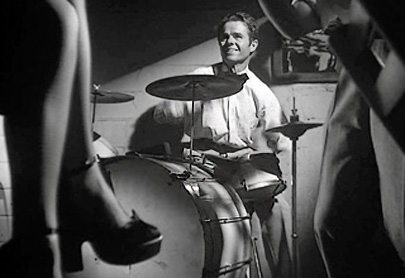
Robert Siodmak made his first indelible mark on noir with this striking adaptation of Cornell Woolrich's novel (written under the pseudonym William Irish), produced by former Hitchcock screenwriter Joan Harrison. With generic studio sets and a low budget, he produced superb set pieces (the underground jazz jam is one of the greats) and dynamic images (credit cinematographer Woody Bredell for the sculpted lighting). Such invention would be mere flourish, however, without the solid script developed and shaped by Harrison (see Eddie Muller's feature on Harrison in NOIR CITY Annual 8 – The Best of NOIR CITY e-magazine 2015) that makes a professional working woman the center of the film—Ella Raines as the Girl Friday turned amateur sleuth trying to save her boss (Alan Curtis) from the electric chair. Franchot Tone takes top billing as a twitchy sculptor, and noir's favorite patsy, Elisha Cook Jr., is a finger-snapping trap drummer at a cheesy musical revue. But it's Raines who shines in a breakout performance. Arrow offers a solid presentation mastered by Universal from original film elements. The image is clear and strong, with deep blacks and sharp contrasts, but there are visible vertical scratches at the 57-minute mark that last for two minutes. The soundtrack is clean and free of distortion. The Blu-ray debut features the 1995 British-TV documentary "Cinefile: Dark and Deadly" featuring directors Robert Wise and Edward Dmytryk and cinematographer John Alton, the 1944 radio adaptation starring Raines and Curtis, plus a booklet with an essay by the FNF's Alan K. Rode.
Arrow - Blu-ray
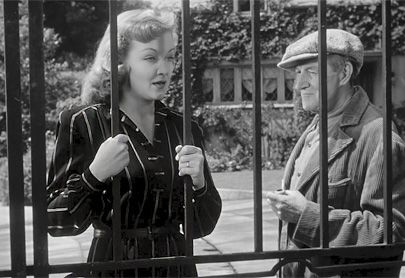
Joseph H. Lewis had over 20 features to his credit, all of them B-movies and most produced on bargain-basement budgets and whirlwind shooting schedules for Poverty Row companies, when in 1945 he made My Name is Julia Ross for the B-unit of Columbia Pictures. A gothic psychodrama with a contemporary British setting, seeped in old-world flavor and based on a Gaslight-style plot, the film was part of the studio's "fewer and better" B-movie initiative, made with a slightly bigger budget and longer shooting schedule. Lewis made the most of his opportunity and his resources. Cool, elegant Nina Foch brings the strength and smarts of a Hitchcock heroine to the character of Julia, May Whitty reveals a cold, conniving mind under her charming front, and George Macready is creepily malevolent as the psychotic son whose eyes flash as he tears Julia's clothes with a knife, as if imagining it's her flesh. Working with Burnett Guffey, a cinematographer who'd help forge the Columbia noir style, Lewis creates suspense with graceful camerawork and dramatic compositions spiked with threatening shadows.
Lewis showed himself more than a mere stylist and his follow-up, So Dark the Night (1946), continues in the continental noir vein. Again working with Guffey, they create an old-world Paris and a sleepy postcard French village on the Columbia lot and surrounding hills of Los Angeles. Steven Geray is heartbreaking as a veteran Paris detective, a gentle soul on his first vacation in a decade, who falls for a young beauty (Micheline Cheirel) who sees him as her ticket out of the sticks. When she disappears on their wedding night, he sinks into despair; then when she's found murdered, he turns anguish into obsession hunting down her killer. The visual palette of Julia Ross is exploited again—ornate rooms turned threatening in the dark, bars across windows turning the manor into a virtual prison, webs of criss-crossing shadows when night falls—and in So Dark becomes a dream-like world of idealized fantasy. And if the narrative twist has no psychological grounding, it reverberates with emotional weight. Where Julia Ross is thrilling and suspenseful, So Dark is suffused in sadness and loss and tragedy, a paradise lost to our tormented detective who follows his mission to the bitter end.
Both films, previously available in noir-themed DVD box sets, make their respective Blu-ray debuts in special editions from Arrow. The excellent masters are clean and clear, with deep blacks and strong contrasts on Julia Ross and a more low-key visual palette, like French poetic realism on a Hollywood backlot, on So Dark. Julia Ross features commentary by noir expert and Film Noir Foundation board member Alan K. Rode and the featurette "Identity Crisis," with Nora Fiore (aka The Nitrate Diva) on the style and themes of the film. So Dark features tag-team commentary by Glenn Kenny and Farran Smith Nehme and a featurette with NOIR CITY contributor Imogen Sara Smith offering sharp observations on the film. Both feature handsome booklets with essays and artwork.
(1985) Warner Archive - Blu-ray
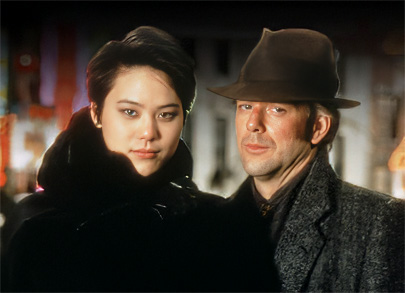
Mickey Rourke is one of the great film noir losers. Like John Garfield before him, Rourke can take characters that are despicable on paper and gift them a humanity that makes them resonate on screen. One of the finest examples is in 1985's Year of the Dragon, now available on Blu-ray through Warner Archive.
Rourke plays Stanley White, a police captain told to crack down on New York's Chinatown. He promptly declares war on the Triads that run the district, sacrificing his reputation and the safety of those around him in the process. The film borrows elements from classic noirs like Cry of the City and The Big Combo, but what makes Year of the Dragon unique is its examination of motive. We're left to question whether White's actions are genuinely heroic or an extension of his personal agenda, given his bigotry towards the Chinese.
Rourke tears through the film with a raw, frenzied performance. White takes advantage of everyone and everything around him, yet the actor makes us feel compassion for the character in his quieter moments. As director, Michael Cimino brings a similarly high level of artistry. He provides an epic quality that's rare for the genre, whether it be through the massive New York soundstages or the breathtaking final shootout. All these elements shine on the new Blu-ray release, which features a commentary by Cimino and the film's original trailer. A must-have for neo-noir fans.
(1959) Olive Films - Blu-ray
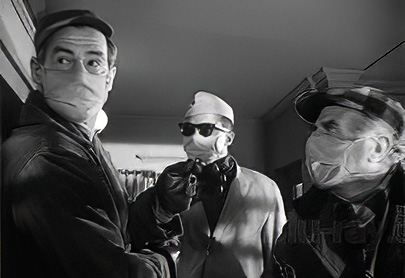
Robert Wise approaches a classic film noir premise—a team of volatile criminals on a heist that goes fatally awry—with a modern style and a story that hinges on the poison of hate, anger, and racism. Harry Belafonte, who developed the project, is jazz musician Johnny Ingram, divorced father of a young daughter and gambler in debt to the mob. Robert Ryan is resentful, hot-tempered war veteran Earle Slater, an ex-con with a history of violence and deep-seeded bigotry, and Ed Begley is Dave Burke, the disgraced ex-cop who masterminds a bank heist in a small town and recruits the two initially resistant men. "One roll of the dice and we're all through forever," he promises, convinced he can keep the tension from exploding despite Earle's constant stream of racist asides and direct threats. Wise produces and directs this independent production and brings a verité feel to the film with austere imagery, location shooting stripped of clutter, and a style that pulls the characters out of the environment in close, intimate shots foregrounding the intensity of their emotional conflicts. The social commentary is hardly subtle—it ends with a literal conflagration and a final image of a sign that reads "Stop / Dead End"—but Belafonte and Ryan are great, Shelley Winters and Gloria Grahame deliver terrific supporting turns, and John Lewis (of The Modern Jazz Quartet) enhances the tension with an unconventional, at times atonal, classical-meets-jazz score. The new Blu-ray of Odds Against Tomorrow from Olive Films is remastered from a recent BFI preservation and looks clean and handsome. No supplements.
(1944) Kino Lorber - Blu-ray and DVD
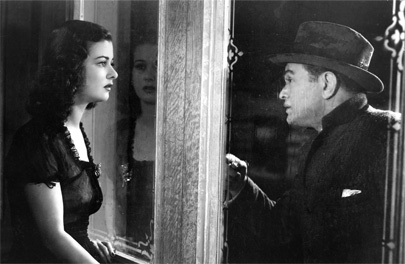
Call Fritz Lang's 1944 classic the proto-Seven Year Itch with a film noir soul. Edward G. Robinson is the middle-aged philosophy professor who meets beautiful young model Kitty (Joan Bennett) on the street. His wife and kids are out of town for vacation so he joins this single and sexy young woman for a nightcap in her apartment. Then, her enraged lover barges in and Robinson ends up a killer, blackmailed by the dead man's sleazy bodyguard (Dan Duryea). Looking back at The Woman in the Window in light of Lang's subsequent Scarlet Street (1945), featuring the same trio in a similar dynamic, you might think it a first draft constrained by production code compromises. The film bends over backwards to make our hapless temporary bachelor utterly sexless, and Bennett plays her role with all innocence, belying that she's a kept woman. And the awkward balance of humor and lurid content gives it a wobbly tone. But the dream twist, criticized at the time of release, allows Lang and screenwriter Nunnally Johnson to suggest the suppressed desires and anxieties of a middle-class intellectual and seemingly content husband and father. Lang shoots the interiors with the classic Hollywood flood lighting style, clean and shadowless, and only goes dark as the night closes in on the professor in exterior scenes (also shot on studio sets, giving the outdoors a claustrophobic quality). The film looks gorgeous in the newly remastered Blu-ray from Kino Lorber and features informed and illuminating commentary by film historian (and regular NOIR CITY contributor) Imogen Sara Smith.
(1946) Kino Lorber - Blu-ray
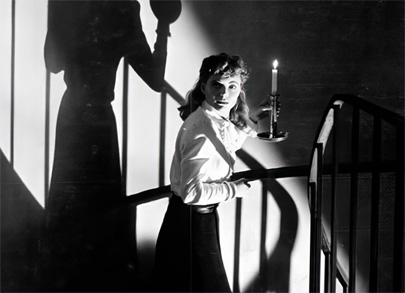
The gothic thriller gets a film noir makeover in the 1946 classic from noir master Robert Siodmak. Set in 1910s New England and largely confined to a grand, shadowy old manor over the course of a single night, The Spiral Staircase stars Dorothy McGuire as the mute servant to a bedridden matriarch (Ethel Barrymore in prime regal form). There's a killer on the loose targeting "imperfect" women and we don't need the ominous shots of a dark figure lurking in the shadows to tell us that the voiceless McGuire is a target. A film in the tradition of Rebecca and Gaslight with a jab of Freudian psychology, this modest genre project is elevated by Siodmak's smart direction, committed performances by Barrymore and McGuire, and the prowling camerawork and masterful lighting of RKO house cinematographer Nicholas Musuraca. The nostalgia of the yesteryear setting gives way to ominous old-dark-house imagery and the stark close-ups of a staring eye (Siodmak's, in fact) giving the film a startling, modern jolt. It's gorgeously made and still quite effective. Newly remastered for Blu-ray from a restored fine-grain master, it looks flawless with rich contrasts and deep, inky blacks. The disc features commentary by film historian and NOIR CITY contributor Imogen Sara Smith, who provides insightful observations and background on the artists and the film's place within noir. There's also a 1949 radio adaptation (not 1945 as the disc cites) starring Dorothy McGuire (providing internal voiceover) and a brief visit with director Siodmak.
(1948) Criterion - Blu-ray
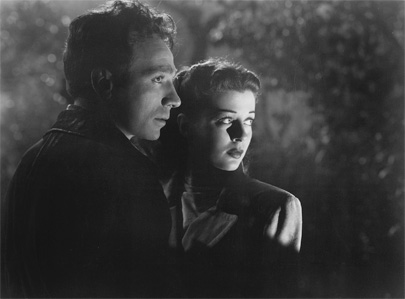
The most authentically romantic filmmaker of classic Hollywood, Frank Borzage made films where the power of love conquered all—not simply narrative obstacles and stubborn complications, but time and space itself. He's the last filmmaker you would expect to produce a film noir masterpiece, yet Moonrise is something special indeed––a small town melodrama with a psychologically tormented hero, directed like a distorted reflection of Sunrise. Dane Clark is Danny Hawkins, a kid from the backwoods orphaned when his father went to the gallows, bullied into an angry young man, and finally pushed into killing a tormenter in a blind rage. Set in a dreamworld of a small southern town ringed in perpetual mist and haunted by the ghosts and sins of the past, it's a world out of time and space created entirely on studio sets. With its poetic imagery, eerily expressionistic flashbacks, and floating camera movement, it has the texture of a silent movie in the sound era. The romance of the title is apt; even in daytime, there is something nocturnal about Danny's lush and claustrophobic and beautifully unreal world. Criterion gives the film its Blu-ray and DVD debut from a 4K digital transfer of the original 35mm nitrate camera negative. This transfer looks amazing with great detail, rich texture, excellent contrast, and a sense of depth to the image. The sole supplement is an informative conversation between film critic and historian Peter Cowie and Borzage-expert Hervé Dumont, and there's a leaflet featuring an essay by Philip Kemp.
(1956) Warner Archive Blu-ray

The final American productions by Fritz Lang, a giant of silent cinema in Germany and one of the great film noir directors in America, are a strange pair indeed. Made for RKO during its precipitous decline under the capricious command of Howard Hughes, with Hollywood greats past their box-office prime and budgets that look threadbare even with Lang's eye, they are sour little portraits of modern America with mercenary heroes in a tawdry culture. His heart doesn't appear to be in these films—his disillusionment with Hollywood seems complete—but they have their moments of nasty satisfaction, especially with actors who sink their teeth in cynical characters.
While the City Sleeps (1956), ostensibly a thriller about a serial killer (John Drew Barrymore) on the loose in the generic big city and the media circus around the investigation, is really more of a media satire centered on a multi-media news company. Dana Andrews stars as a TV newscaster competing with the company's daily paper and a wire service. Ida Lupino is the newspaper columnist whose nose for office politics is her greatest survival skill, the first among equals in a cast of wily Hollywood pros: Rhonda Fleming, George Sanders, Howard Duff, Thomas Mitchell, and Vincent Price. Lang seems to have given up trying to create any sense of tension or menace in Barrymore's scenes as the psychotic leatherboy who kills girls over mommy issues, but it's a pleasure watching the old pros become sharks in the newsroom when playboy Price inherits the business and pits his employees against one another as they vie for promotion.
(1956) Warner Archive Blu-ray
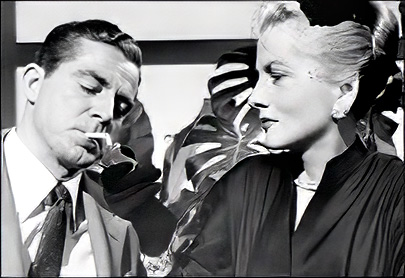
Dana Andrews is back in the lead for Beyond a Reasonable Doubt (1956), Lang's final American feature, as a novelist who ends up framing himself for murder in an elaborate anti-capital punishment protest. Joan Fontaine is his fiancée who goes desperately in search of any evidence to exonerate him. It makes an odd little bookend to Lang's 1930s dramas of social protest and it boomerangs back with a weirdly cynical twist. Andrews lets a lecherous side show through as he chases a showgirl (part of his stage-managed scheme that he embraces a little too creepily) and anyone familiar with Lang's disdain for Hollywood's contrived happy endings will have a field day imaging how Lang would have preferred to end this barbed little picture.
Both While the City Sleeps and Beyond a Reasonable Doubt are presented in the SuperScope process, a cheap widescreen alternative to the anamorphic CinemaScope process that involves masking and re-photographing the negative in post-production to create an anamorphic print. By the mid-fifties, as Hollywood tried to counter the threat of TV, it was standard practice to project films in aspect ratios somewhere between 1.66:1 and 1.85:1 and Lang surely framed these films with that in mind. These discs present the SuperScope editions at 2:1, which results in cramped compositions in some scenes, suggesting it was imposed by the studio in post-production though it will take more detective work to confirm what Lang actually intended. The new 2K Blu-ray masters show the increased grain inherent in the process. While softer than true widescreen productions, it looks fine, with good contrasts and clean images.
(1953) Twilight Time - Blu-ray
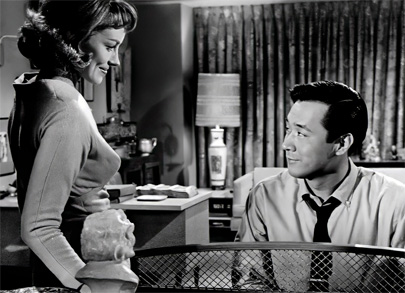
Sam Fuller knows how to grab an audience. After the credits play over a time-lapse painting of a woman in a kimono from sketch to completion, we are immediately slammed into "Los Angeles—Main Street": a montage of seedy burlesque club and strip joint marquees at night that ends with a brassy blonde stripper running half-naked through the streets. The tawdry tabloid energy gives way to a police procedural, but the real story of The Crimson Kimono is the buddy drama between police detective partners Joe (James Shigeta), a Japanese-American married to the job, and easy-going Caucasian cop Charlie (Glenn Corbett): roommates, best friends, and battlefield blood brothers whose friendship is upended by a girl (Victoria Shaw). It's a romantic triangle tangled up in cultural identity and racism, and Fuller offers an interesting flip on his approach to race in America (a theme that goes back to his 1951 Korean War drama The Steel Helmet). Set in L.A.'s Little Tokyo, the blasts of Japanese culture offer fresh flourishes to familiar genre conventions. Anna Lee, playing a skid row artist with a taste for bourbon and cigars, is one of the greatest of Fuller's gallery of streetwise eccentrics. For all of the director's commitment to the celebration of racial and cultural diversity, The Crimson Kimono remains more interesting than illuminating or dramatically gripping. The Blu-ray debut from Twilight Time presents a crisp master of the black-and-white image. It carries over two featurettes from Sony's 2009 The Samuel Fuller Collection DVD box set and features an isolated soundtrack and booklet.
(1948) ClassicFlix - Blu-ray
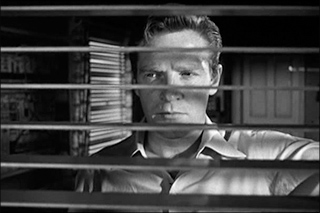
Some noir films are so adept at telling the story visually that the inclusion of dialogue becomes incidental. He Walked by Night (1948) is one such case. At an airtight 79 minutes, the film chronicles the LAPD's efforts to apprehend Roy Martin (Richard Basehart), a burglar responsible for killing one of their own. Despite its tired premise, it excels by providing cinematographer John Alton with a chance to flex his incomparable skill in nearly every scene.
In addition to maintaining a cohesive style under two directors (Alfred L. Werker and an uncredited Anthony Mann), Alton builds upon each of Martin's volatile encounters, like a recurring and foreboding theme. Dialogue is kept to a minimum whenever the killer appears, with auditory and visual tactics used to heighten tension. It works brilliantly. Then, of course, there is the film's iconic finale, where the cops chase Martin through the city's underground sewer system. The imagery here all but overloads the ocular senses, with reflective surfaces puncturing the darkness and chiaroscuro wielded with a precision that leaves subsequent examples underwhelming in comparison.
ClassicFlix's Blu-ray gives He Walked by Night the definitive home release. The picture transfer, capturing every flicker and visual flourish, is immaculately handled, as is the audio commentary by film historians Alan K. Rode and Julie Kirgo. Additional perks include the featurette "Below the Surface" and a lush, 24-page booklet by author Max Alvarez (and designed by the FNF's Michael Kronenberg) that details the film's perplexing directorial history.
(1955) Warner Archive Blu-ray
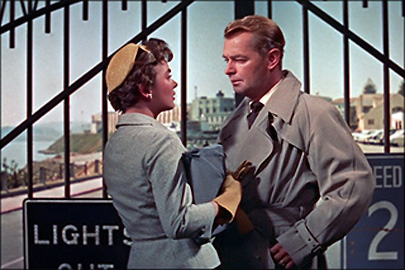
Despite its saturated, widescreen WarnerColor photography, 1955's Hell on Frisco Bay offers familiar noir shenanigans with Alan Ladd typecast as Steve Rollins, a grim ex-cop attempting to settle a score with a menacing San Francisco mob kingpin. Said mobster, Vic Amato, is played by Edward G. Robinson in full "now don't get sore, see" mode, fully unrepentant for sending decent-guy Rollins to San Quentin on a false murder rap. Spurred on by a Biblical "vengeance is mine" morality, Rollins sets out to kill the men who framed him despite the pleas of his former love (Joanne Dru), an elegant nightclub singer. Rollins comes to realize, however, that Amato's death-grip on the city's police force and business community has made himself the target. Although the script depends too heavily on Ladd and Robinson's well-established screen personae, Hell on Frisco Bay is a watchable-enough crime melodrama bolstered by an array of fascinating supporting characters (Fay Wray's poised, yet anxious, movie-queen-turned-gangster's-moll, for instance). Parts of the Frank Tuttle-directed movie were filmed throughout San Francisco, causing some jarring transitions between outdoor locales and sterile studio-bound scenes. Warner Archive's Blu-ray edition sports a pristine picture and lush sound (in mono), a fitting venue for a typically grandiose score from Max Steiner.
(1947) Kino-Lorber - Blu-ray
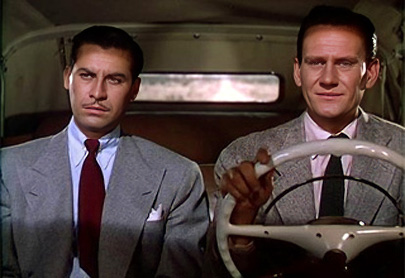
Film noir's Technicolor white whale finally surfaces on home video. A bevy of homegrown stars from producer Hal Wallis' stable enacts a panoply of psychosexual weirdness against scorching Southwestern vistas. Poor little rich girl Lizabeth Scott flounces home from yet another boarding school to the not-so-loving arms of her mother, Arizona gambling queenpin Mary Astor, who'd rather be introduced as her sister. Also returning to this dusty burg is "cheap gangster" John Hodiak, accompanied by overly familiar sidekick Wendell Corey. As Scott and Hodiak swoon, everyone else in town, including laid-back lawman Burt Lancaster, prepares for the fallout. Robert Rossen's script consists of whipcrack dialogue and an inordinate number of scenes of the lovers driving between each other's houses. Director Lewis Allen ably banks the fires under the hothouse atmosphPere, keeping things amiably preposterous. The main question, of course, is how does this long-sought film look? Aside from occasional age-induced softness, usually in exterior shots, the image has tremendous vibrancy. The reds, blacks, and greens of the roulette tables at Astor's casino pop off the screen, and every paillette is visible in costume designer Edith Head's pull-out-all-the-stops wardrobe of classic resort wear. Miklós Rósza's score has never sounded more ludicrously lush. NOIR CITY contributor Imogen Sara Smith provides an engaging commentary track that touches on the film's curious melding of genres (the melodrama-Western-noir?) and the many undercurrents that led FNF honcho Eddie Muller to dub it "the gayest movie ever produced in Hollywood's Golden Era." A curio worth collecting.
(1946) Criterion - Blu-ray
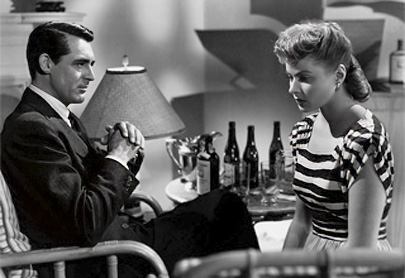
Alfred Hitchcock's Notorious is exhibit "A" in the case for the glory of classical Hollywood moviemaking at its apex. After battling micro-managing producer David Selznick over Rebecca and Spellbound, Hitch was largely left alone to shape this swoony, sexually charged spy thriller with screenwriter Ben Hecht. The result is his most deliriously romantic film, silky and sophisticated with a dangerous, darkly suggestive undercurrent of sex and sacrifice. Cary Grant and Ingrid Bergman don't throw off sparks so much as smolder passion which Grant's American agent, who recruits the disreputable Bergman to infiltrate a society of Nazis in hiding, attempts to douse out of duty. It's a relationship played mostly in code and prone to misreading as they mask their emotions out of pride and bitterness. Hitchcock elevates Hecht's beautifully understated dialogue with the intimacy of his direction and delivers a finale in slow motion, a battle of wills as theater, played for an audience of incredulous war criminals. It's a masterpiece.
Notorious is newly remastered by Criterion in a 4K restoration from the original camera negative and other archival preservations. It's flawless and the special edition offers a new visual essay by David Bordwell on the direction of the finale (which he calls Hitchcock's "Odessa Steps"), a featurette on Hitch's pre-visualization process, and interviews with cinematographer John Bailey and Hitchcock biographer Donald Spoto, plus two commentary tracks carried over from previous releases, a 2009 documentary, the 1948 radio adaptation, and a fold-out leaflet among the supplements. A superb edition of an essential classic.
(1947) Criterion - Blu-ray
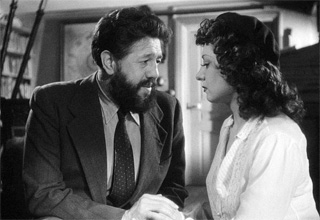
Julien Duvivier, one of the godfathers of French poetic realism, announced his return home from his World War II Hollywood sojourn with a dark, savage French noir. Based on the novel Monsieur Hire's Engagement by the prolific Georges Simenon, Panique stars Michel Simon as the eccentric Hire, an aloof misanthrope eyed with suspicion by his gossipy neighbors. As he stalks his beautiful new neighbor (Viviane Romance), peeping through windows and spying around corners, we figure they may have a point. Then, as he opens up to her about his life of loneliness and betrayal, she helps a charmingly ruthless small-time crook (Paul Bernard) frame Hire for the murder that the crook committed.
The novel was more faithfully remade by Patrice Leconte as Monsieur Hire (1989), but this is a striking and dramatically satisfying noir-tinged portrait of ordinary people roused to a veritable lynch mob through prejudice and suspicion and poisonous gossip turned sour indictment of collaboration and anti-Semitism in Vichy France. It didn't endear Duvivier to those who stayed behind when he fled for America but it still carries a sting. Criterion presents a gorgeous new 2K restoration on Blu-ray and DVD, crisp and creamy with deep shadows and strong contrasts, and presents a new, more accurate subtitle translation by Lenny Borger. There's a featurette with French critics Guillemette Odicino and Eric Libiot discussing Duvivier (in French with subtitles), a new interview with Pierre Simenon (son of novelist Georges Simenon) in English, and the illuminating featurette "The Art of Subtitling" produced and hosted by Bruce Goldstein.
Kino Lorber - Blu-ray
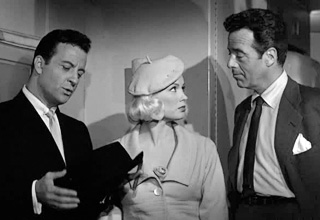
Mamie Van Doren never reached the status of fellow blonde bombshell Marilyn Monroe, but her curvy figure and caustic attitude made her a fixture of 1950s film noir. The Mamie Van Doren Collection compiles three such films on Blu-ray for the first time providing a snapshot of the actress at her peak, as well as a sampler of some of the decade's lesser-known titles.
The Girl in Black Stockings (1957) opens at a posh resort where the mangled body of a female guest is found. Anne Bancroft and Marie Windsor head up the suspect list, and their performances go a long way in elevating Howard Koch's workman-like direction. Van Doren's screen time is limited, but her turn as a tipsy gold digger is a colorful highlight.
1960's Vice Squad pushes Van Doren to the forefront as a conflicted call girl. The film touches on weighty topics like rape and prostitution, but director Edward L. Cahn is woefully out of his depth, leaving Van Doren as the only bright spot. The duo fares much better with the lean Guns, Girls and Gangsters (1959).
Here, Van Doren plays a torch singer who helps knock over an armored truck. The actress benefits from Cahn's tight direction, whether she's singing tunes or trading barbs with tough guys Gerald Mohr and Lee Van Cleef. All three films look terrific in their remastered form, and the extras include an interview with Van Doren herself. A worthwhile collection spotlighting one of noir's unsung veterans.
(1965) Network - Blu-ray
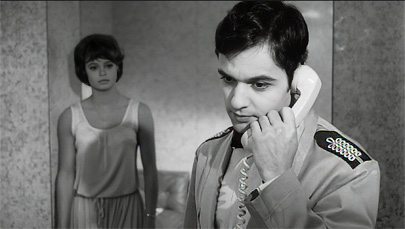
When I saw this on an early '70s late show, I felt I'd stumbled on the perviest movie ever made. "Felt" is accurate; I was too young to comprehend its sexual psychobabble. But the gloomy, guilty, seething, sweaty, voyeuristic eroticism was palpable. Making it even creepier was that the players—Sal Mineo, Juliet Prowse, Jan Murray—completely flipped their familiar personas I'd gleaned from TV. (Chat-show comic Murray plays a kink-obsessed cop without a trace of humor.) There's no graphic sex or violence; it's the tone of Who Killed Teddy Bear that makes it slimier and stickier than the floor of a 42nd Street grindhouse. It was only a matter of time before this grimy curio oozed back into the mainstream, billed by its publisher as a "neo-noir masterpiece."
Ahem. This is a virtually plot-free stalker film, one with enough faux psychology to plop it into a subgenre I call "Freudsploitation." You know, childhood sex trauma leads to a life of misogynistic murder for the men or nymphomania for the gals (then there's poor, frigid Marnie). Director Joseph Cates had already made Girl of the Night (1960), in which Anne Francis is a call girl being "studied." Who Killed Teddy Bear is ostensibly about Mineo's bubbling-over psychosis, embedded when his sexual initiation resulted in an accident that leaves his sister brain-damaged and forever in his care. Mineo, however, seems to be starring in his own entirely different movie—a homoerotic paean to Marlon Brando, whom he self-consciously emulates in scenes that "study" his buffness with a gaze verging on gay porn. (Mineo's actual predilection for rough trade, and his eventual murder, give the whole tawdry affair a tragic undercurrent.)
The angle here is that everyone's a potential perv, save the lusted-for heroine, who's so naïve she takes time to scold her chronic obscene phone-caller. Even her boss, played by venerable NY stage actress Elaine Stritch, works a Sapphic come-on, one of the few moments that almost feels believable. Mostly, it's prolonged scenes of wild dancing, verité forays around Forty-deuce, leering pans of smut-mags, Prowse's languorous disrobing—these scenes eat up so much screen time they can't be called "gratuitous." They're the picture's raison d'être.
There were intriguing contributors to this sleazy smorgasbord. The star of the show, DP Joseph Brun, shot the noir classic Odds Against Tomorrow (1959). Co-screenwriter Arnold Drake was a DC comics vet, penning tales for The Doom Patrol, Deadman, and Teen Titans, as well as the original "graphic novel" It Rhymes with Lust (1950), an illustrated film noir drawn by the renowned Matt Baker. Co-writer Leon Tokatyan would have hundreds of credits in episodic TV, including a long run with Lou Grant. Daniel J. Travanti (Hill Street Blues) and Bruce Glover (Chinatown) show up in bit parts. Did they list Who Killed Teddy Bear on their résumés? Oh well, it's back to haunt them now.
The Blu-ray I viewed would periodically go soft in spots—but not enough to distract from the clammy creepiness of Brun's images. Supplements include an episode of the TV series Court Martial starring Mineo, a goofy short on LSD, some promo art and stills, and an original theatrical trailer. It should come packaged with a bath towel for the hot shower you'll need afterwards.
(1947) Kino Lorber - Blu-ray
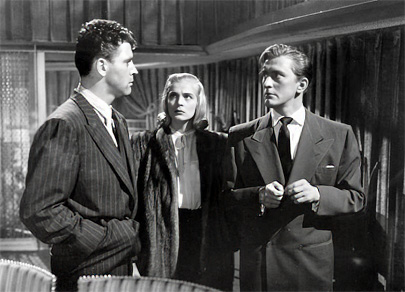
Burt Lancaster, teeth gritted and nostrils flaring, storms through 1947's lush I Walk Alone as Frankie Madison, a hardened ex-con out to even the score with the man who double-crossed him in a botched bootlegging escapade. Fourteen years after his conviction, Frankie emerges from the clink zeroing in on his ex-pal Noll "Dink" Turner (Kirk Douglas), who parlayed the duo's stolen cash into a bustling, swanky nightclub. Dink begs to differ when Frankie rightfully seeks his fair share of the earnings, using his high-society connections to keep his hot-headed buddy in check. Frankie, however, winds up finding a pair of surprisingly sympathetic allies in willowy pianist Kay (an appealing Lizabeth Scott) and his brother Dave (Wendell Corey, solid as always)—the club's milquetoast accountant and a vital link to Frankie and Dink's past. Lively pacing and excellent performances abound in this glossy Hal B. Wallis production, ably directed by Byron Haskin (Too Late for Tears, The War of the Worlds) in a way that emphasizes affecting drama over cold cynicism. Want star power? Check out the electricity between Lancaster and Douglas (oozing with smarm as the perfect heel) in the first of their many collaborations. Kino Lorber's Blu-ray edition is sourced from a handsomely restored 4K scan of the film's 35mm negative showcasing some impressive, brilliantly lit black-and-white cinematography. A newly recorded audio commentary from film historian Troy Howarth supplies copious background info on this tough, compelling noir.
(1952) Twilight Time Blu-ray
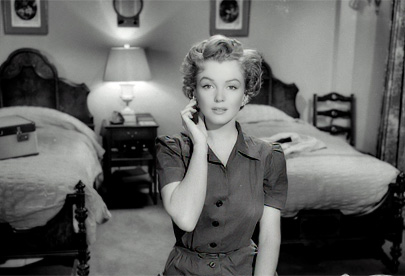
Contained entirely within the confines of a not-quite-luxurious New York hotel and observed over the course of a long, dark night of a young soul, Don't Bother To Knock doesn't have the familiar noir look—handsomely shot on modest studio sets by Lucian Ballard, it has no ominous shadows, slashes of light, or precarious angles—or themes. What it offers, along with Richard Widmark as a co 94mmitment-wary airline pilot and the debut of 21-year-old Anne Bancroft as an experienced-beyond-her-years nightclub chanteuse, is rising 20th Century–Fox starlet Marilyn Monroe as a small-town girl unraveling on a babysitting assignment. Instead of the twitchy behavior of a classic paranoid schizophrenic movie character, pinging from one emotion to another, Monroe's performance is quiet and scared and she uses that breathy delivery (so effective in her sexy innocent roles) to define a fragile, wounded girl losing her grip on reality. British filmmaker Roy Ward Baker, making his American debut (as Roy Baker), uses the maze of hallways and elevators and compartmentalized spaces to create an atmosphere of disconnection and dislocation and delivers a delicious play of flirtation and voyeurism through keyholes and the facing windows across the courtyard of the U-shaped hotel, with blinds dropping and rising up in invitation, all in a tight 75 minutes. The new Twilight Time Blu-ray looks clean and sharp and creamy and includes short documentaries on Monroe and Widmark originally produced for A&E Biography, plus an isolated music track and booklet.
(1948) Kino Lorber Blu-ray
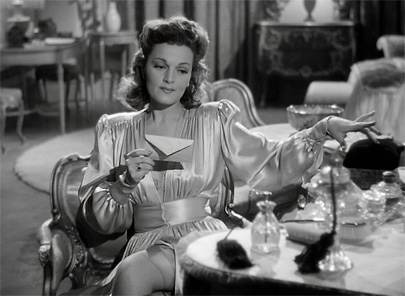
A British take on American crime cinema, No Orchids for Miss Blandish is adapted from a salacious novel by James Hadley Chase. It features cold-blooded gangsters colliding with high society and throws out sexual suggestions that American movies hadn't allowed since the pre-code days. So how do these combustible elements fail to ignite? Imported American B-movie actor Jack La Rue is tough but inexpressive and never genuinely commanding as the ruthless thug who falls in love with the jaded heiress (Linden Travers) his gang has kidnapped. We have to take their hot-and-heavy romance on faith as their chemistry is inert at best. The static direction by St. John Legh Clowes (who also scripts) fails to bring a savage edge to the mercenary twists, and the slipping accents and generic settings don't quite get the American vernacular, giving it all a weird, unreal atmosphere. There's more fun to be found around the details at the edges of the story: a reporter (Hugh McDermott) who peeps on a showgirl getting undressed, gang members shacking up with their latest conquests, and a cigarette girl whose outfit features a zipper that plunges right down the front (and gets tested by more than one customer). The film was condemned by the British press, but for all its notoriety it's little more than a curiosity. The new Blu-ray and DVD editions from Kino Lorber features a strong, sharp picture and is a significant upgrade from the previous DVD from VCI. No supplements beyond a trailer.
(1961) Twilight Time Blu-ray

Underworld U.S.A., a "kino-fist" crime thriller from Hollywood's great independent, is a revenge drama driven by one of director/writer/producer Samuel Fuller's greatest anti-heroes—Cliff Robertson as street kid turned safecracker Tolly Devlin. Tolly nurtures a near sociopathic purity of purpose behind his crooked smile and twinkling eyes, but in contrast to the boardroom thugs of the syndicate who send "field agents" (a bland euphemism for drug dealers) to schools to expand their customer base, he at least has a code. And like Skip McCoy in Pickup on South Street, this defiantly apolitical survivor is roused from apathy when confronted by the brutal culture of organized crime he's been trying to play. Fuller carves out his Underworld on the tiny budget of an independent production, creating his city entirely from studio sets shot by Hal Mohr (who has a long career of noir bona fides) with a hard-edged look that turns the anonymous, enclosed cityscape into a kind of prison for Tolly, who never escapes the alley where his father was murdered. There's a jagged quality to the narrative keeping the film and the characters off-balance, and behind the pulp melodrama is Fuller's take on the crime syndicate as cold-blooded big business. The Blu-ray debut from Twilight Time presents a crisp master of the black-and-white picture and features an isolated soundtrack and a booklet. The featurette "Sam Fuller: Storyteller" (24 min.) and Martin Scorsese's video introduction (5:08 min.) were originally produced for Sony's Samuel Fuller Collection DVD box set.
(1985) Shout! Factory - Blu-ray
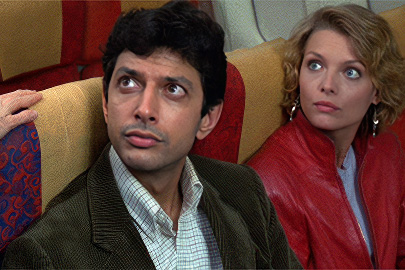
John Landis is not a name you connect to the neo-noir boom of the '80s, but his 1985 Into the Night takes a classic noir situation—the middle-class innocent (Jeff Goldblum, in his first leading role) jolted out of his protected-but-dull existence and plunged into a nightmarish odyssey through the urban underworld—and gives it a charge of romance and an edge of danger. Michelle Pfeiffer (in her first lead) is the tough-talking former model and jilted mistress who smuggles the film's MacGuffin into L.A. and ends up targeted by both gangsters and Goldblum, a bystander who provides her getaway and then sticks around.
Into the Night plays like the flip side of Martin Scorsese's After Hours, where the suburban guy caught in the nocturnal city finds he's not only more at home in the dark than in the mundane routine of his daytime life—he thrives on the danger. The insomniac who sleepwalks through his days comes alive, finding not just inner strength but an old-fashioned sense of chivalry and a surprising calm in the midst of chaos. Landis has fun without making fun of it, and the mix of B. B. King guitar lines through the synth score is surprisingly evocative. Shout! Factory's newly remastered Blu-ray preserves the rich, deeps colors evoking the city at night, and features new interviews with John Landis and Jeff Goldblum, plus a 26-minute TV documentary with B. B. King and Landis.
(1947) ClassicFlix - Blu-ray
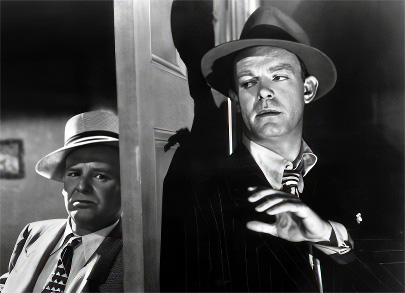
Of the countless "docu-noirs" released during Hollywood's golden age, none are as slyly contradictory as the 1947 classic T-Men. A fictional retelling of an actual treasury case, the film cuts through its cloying propagandic message with a startlingly bleak depiction of the criminal world in which its titular agents (Dennis O'Keefe and Alfred Ryder) are forced to navigate—a world where the smallest mistake can mean the difference between life and death, regardless of what side you're on.
T-Men has strong narrative tension, as the threat of violence constantly looms over its undercover agents, but for the most part the screenplay takes a back seat to the extreme stylings of director Anthony Mann and cinematographer John Alton. In this, the first of their six collaborations, the duo blend shadows, smoke, and sordid location shooting into a hypnotic visual brew. Each scene could be bottled and sold as emblematic of the film noir aesthetic, due to Mann's dynamic framing of tough guys O'Keefe and Charles McGraw, and Alton's mastery of single-source lighting, always accentuating the uncertainty of the surroundings. Their efforts ensure that the film's stilted (and mercifully sparing) narration doesn't deter from its momentum.
All this comes expertly packaged in ClassicFlix's new Blu-ray release. In addition to a superb digital restoration, T-Men comes with a booklet by author Max Alvarez, a commentary by Alan K. Rode, and a pair of featurettes, the more notable of which includes an interview with Anthony Mann's daughter, Nina.
Arrow Films UK
FORCE OF EVIL (1948) / THE DARK MIRROR (1946) / SECRET BEYOND THE DOOR (1947) / THE BIG COMBO (1955)
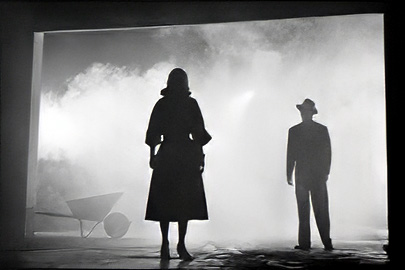
UK distributor Arrow Films has released a handsome, limited-edition box set (complete with Saul Bass-inspired artwork) that includes Blu-ray/DVD combo packs of four noirs originally released in the U.S. by Olive Films.
If we're being honest, the "classic" label only applies to two of the selections: The Big Combo (1955) and Force of Evil (1948). The former follows a trio of characters—single-minded cop Leonard (Cornel Wilde), quietly psychotic gangster Mr. Brown (Richard Conte), and Susan (Jean Wallace), the tortured woman stuck between their two competing agendas—as they circle each other, their flaws and weaknesses pushing them into some of noir's darkest corners. The film boasts some genuinely nasty content for a 1955 release, as well as some of legendary cinematographer John Alton's finest work. The latter, a searing indictment of conscience-free capitalism from Body and Soul (1947) scribe Abraham Polonsky, stars the typically excellent John Garfield as Joe, a corrupt lawyer caught between Tucker, his numbers-running client, and one of Tucker's targets: Joe's younger brother, Leo (Thomas Gomez). Martin Scorsese's citation of its influence on several of his movies provides a sufficient indicator of its quality. + READ MORE